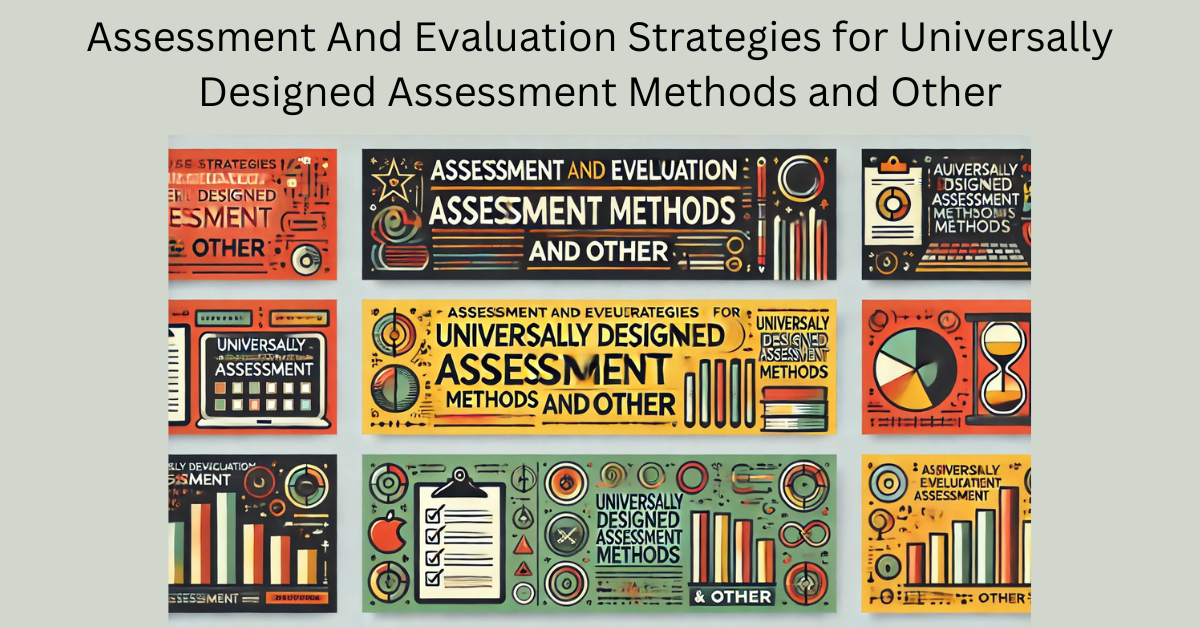Many Assessment And Evaluation Strategies for Universally Designed Assessment Methods and Other are used in nursing Academic for different levels of programs. These strategies are very specific to evaluation.
Universally Designed Assessment Methods: Assessment And Evaluation Strategies
Thompson, Johnstone, Anderson, and Miller (2005) conducted a Delphi survey of test writers and developers to determine guidelines for assessment that is universally designed and accessible. Following these guidelines for test question development will make the test accessible to the broadest range of learners. These guidelines are also helpful when selecting test items from textbook associated instructor test banks for Assessment And Evaluation Strategies.
The reading level of written tests, particularly in the year before taking national licensure examinations, should be consistent with the reading level of the national licensure examination. Many word processing programs allow the user to determine the reading level of a test. The use of medical terminology with multiple-syllable words can increase the reading level of a test and this should be taken into consideration when using reading level indexes.
Scoring And Determination Of Item Difficulty And Discrimination
A good test question discriminates between the students who know the concepts and poor students who are guessing, and the more difficult a question, the more challenging it is for even good students. If weaker students get a question right and better students get a question wrong, the question does not discriminate correctly. Scoring programs for written tests can provide information on difficulty and discrimination of test items.
If a scoring program is not available, a simple way to check for difficulty and discrimination of test items is to compare students with scores in the top third of the group to the students in the bottom third of the group for that examination. If a question is answered correctly by the top third of the class and the bottom third of the class answered incorrectly, it is likely that this question is more difficult and discriminates effectively.
Checking difficulty and discrimination of test items is important, particularly if a large percentage of the class answered an item incorrectly. If a test question discriminates against a good student, the test item needs revision. Review of the test results with individual students can provide insight into student interpretation and misinterpretation of a question.
After reviewing test results with several students and getting student input, faculty may determine ways to strengthen misleading items or response in the test, as well as determine topical or content areas that may need further clarification.
Other Methods Of Course Evaluation: Assessment And Evaluation Strategies
Other methods of course evaluation can include papers; projects, both individual and group; presentations; observations; and concept mapping. These methods require a list of criteria on which the project will be graded. Use of assessment rubrics and grading scales increases objectivity in these methods of course evaluation.
Papers And Projects
Papers are used to determine higher levels of critical thinking, a student’s ability to research, synthesize, and reflect on a topic, and to assess values associated with affective thinking. A student could write a paper about a case study situation from practice, researching the literature for current approaches to practice. Before clinical experiences, students can be assigned a nursing care plan or nursing concept map to show preparation and level of knowledge needed for the experience.
A critical reflection paper could be required after a clinical experience to demonstrate analysis of a clinical situation. Another paper could require that a student explore an ethical dilemma encountered (or told about) in practice. The guidelines for the paper should include a list of items to be included and criteria for grading the paper. Components of the nursing process are frequently included in paper requirements for nursing problems.
The paper structure and format should be specified including whether the paper can be hand-written or word-processed, and the number of references required. Specify the number of grading points assigned to the respective criteria. Length of the paper varies with the topic and purpose of the paper. A paper exploring an issue or policy may be seven to ten pages, requiring the student to synthesize and evaluate in a concise manner, whereas a research paper with extensive references may be longer.
Papers take longer to grade than multiple-choice examinations and this should be facto red in by faculty when determining paper requirements, keeping in mind that it can be more difficult to write a concise analytical paper; length does not automatically correlate with writing and thinking abilities. One way to increase grading reliability is to have two to three papers independently evaluated by a faculty peer.
Papers can show that the student has effectively grasped the more complex concepts associated with course content and outcomes. Projects done individually or in groups can require a psychomotor skill as well as cognitive and affective thinking. An individual project could entail designing and displaying a health promotion poster in a community setting, or presenting projects to peers.
The grading criteria should include a list of the project components with points and percentage of grade assigned to each component. Criteria related to content, references, layout, appearance, and reading level promote objectivity of evaluation and clue the learner into expectations for the desired product. Group projects can promote collaboration and communication that reflect characteristics desired in professional practice.
When group projects are assigned, specify expectations for group members that include criteria with points assigned. Group members could provide peer assessment using a rating scale of dissatisfaction to exemplify criteria, such as quality of work, task completion, timeliness, attitude, and contributions to group work, all of which reflect qualities of team work desired in nursing practice.
Classroom Presentations
Classroom presentations include components of both content and delivery skills. The evaluative criteria for the classroom presentation links to the course purpose of the classroom presentation. In some courses, students research topics not covered elsewhere and give an informal presentation to the class about the specific topic. Then the majority of the evaluative criteria are an outline of presenting content associated with the topic.
If the purpose is to gain skills in professional nursing presentations and the nursing topic is secondary, more detailed criteria and grade points pertain to delivery of the presentation. Evaluative criteria for the presentation content includes an introduction, body, and concluding summary, similar to what is included in a written paper.
If it is important that specific content be included in the presentation, include evaluative criteria pertaining to the specific content. For example, in a cardiovascular nursing course it may be important for the presentation to include pathophysiology and rehabilitation components specifically related to cardiovascular nursing. A general content outline embedded in the criteria conveys to the learner areas of importance and can avoid misunderstandings as well as missing content.
Criteria for the informal classroom presentation may include a clear introduction related to the topic, a presentation that can be heard, eye contact, and no distracting mannerisms (eg, uhs, playing with hair, distracting hand/body movements). The delivery of informal classroom presentations can be secondary to the content associated with a topic. The informal classroom presentation may not require the student to dress other than in what is customary for the classroom; if more professional attitude is expected, related evaluative criteria is stated.
Evaluative criteria for delivery of formal presentations should be consistent with expectations for professional presentations, level of formality, and the type of audience. The evaluative criteria include areas such as: a clearly articulated purpose or topic; gaining attention with an anecdote, starting statement, or unusual statistics; being knowledgeable and organized; maintaining listener (student peer) attention; varying pace and tone; time length, and a concluding summary that recaps key points and signals closure for the audience.
McCullen (1997) offers criteria related to elocution and eye contact as part of a presentation rubric. Sample rubrics for assessing classroom presentations and oral expression have been developed by pre-college educators and are available online at Technology (1999–2006). These offer a good starting point for developing evaluative criteria for nursing classroom presentations. Evaluative criteria for classroom presentations embedded in a rubric convey to the student what is expected, can be used by peers, and add objectivity to the evaluation of classroom presentations (Allen, 2003) for Assessment And Evaluation Strategies.
Observations
An effective means of assessment is observation in the classroom and clinical laboratory. Observation requires assessment rating scales or rubrics to promote objectivity and clearly identify expectations for the student. A rating scale of “not demonstrated” or “demonstrated” can be included on a skills checklist as Assessment And Evaluation Strategies.
Facione and Facione (1994) developed a holistic critical thinking scoring rubric, which could be used to evaluate student critical thinking in an observation. Two faculty members (or two students) could independently assess a demonstration and then compare ratings; revise the tool as needed to increase reliability of measurement.
Concept Mapping
Concept maps can be used to evaluate whether a student can demonstrate relationships and connections between concepts. The concepts can be diagramed and clustered with arrows between concepts to show a visual representation of cause and effect. Such a diagram can demonstrate how a student connects—accurately or erroneously—patient assessment data, prioritizes information, and identifies nursing actions connected to the patient assessment data.
Concept mapping is being used instead of the traditional nursing care plans (Koehler, 2004). Evaluation of a concept map requires criteria about content, size, and general guidelines. A sample concept map, included in the course syllabus, and a grading rubric provide student guidance and foster objectivity for Assessment And Evaluation Strategies.
Rubrics for Grading and Assessment
An assessment rubric, includes grading criteria for an assignment and signals to students the level of work expected on a grading scale of numerical or letter grades. Mertler (2001) describes analytical and holistic rubrics. The holistic rubric is designed to grade a process or product. A holistic rubric could be developed to score a class presentation, with characteristics of an excellent to poor presentation identified (Truemper, 2004) Assessment And Evaluation Strategies.
Moskal (2000) pro vides rationale for using rubrics and a linear example of a holistic rubric for grading a paper. A formal paper may have points assigned to the introduction, body, conclusion, format, and length. The student learner then knows the level of work needed for the grade desired. The instructor using the grid increases objectivity when assigning grades. If a class is being team-taught, having faculty independently evaluate an assignment and then comparing evaluations can increase reliability of the tool, with modifications made as needed.
Summary
Strategies Ongoing assessment and evaluation of program components assists faculty to identify any problematic areas and strengthen program quality. Student and course evaluation contribute to overall program assessment. Course outcomes and methods of evaluation should demonstrate increasing levels of Bloom’s revised taxonomy. Test items must be developed with increasing difficulty and discrimination throughout the program, and be designed around universal standards for Assessment And Evaluation Strategies.
Evaluative methods provide students with feedback on achievement of course content and outcomes. Grading rubrics for non-testing methods of evaluation illustrate expectations for levels of learning and foster grading objectivity. Faculty members compare internal and external standards in an ongoing assessment and systematic program evaluation to promote quality in and preparation of program graduates for the nursing profession for Assessment And Evaluation Strategies.
Read More:
https://nurseseducator.com/assessment-and-evaluation-strategies-program-assessment-and-evaluation
https://nurseseducator.com/assessment-and-evaluation-strategies-methods-of-course-evaluation
Social Links:
https://www.facebook.com/nurseseducator/
https://www.instagram.com/nurseseducator/



